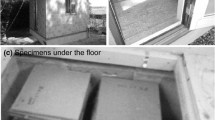Abstract
The equilibrium tensile properties of urea-formaldehyde (UF)- and phenol-formaldehyde (PF)-bonded particle boards have been studied at moisture contents between 1 and 33% and at temperatures between −15°C and +45°C. These conditions may occur e.g. during exterior use of the boards. The tensile strength and the modulus of elasticity decrease slightly while the strain at rupture increases slightly between 1% and 7% moisture content. These effects are similar for UF- and PF-bonded boards. Above 7% moisture content the tensile strength and the modulus of elasticity decrease markedly while the stretch at rupture increases with increasing moisture content. These changes are more pronounced for UF-bonded boards. The bending stiffness is less affected than the modulus of elasticity since the board thickness increases with increasing moisture content. The tensile properties are not significantly affected by the temperature at low moisture contents, but at high moisture contents the combined effects are more pronounced. The effect of moisture is generally stronger than that of temperature, in the range studied.
Abstract
Die Zugfestigkeit von karbamidharz(UF)-und phenolharz(PF)-verleimten Spanplatten im Ausgleichszustand wurde in einem Feuchtig-keitsbereich von 1 bis 33% und bei Temperaturen zwischen −15°C und +45°C untersucht. Diese Verhältnisse können z. B. in einer Außenwand vorkommen. Zugfestigkeit und Elastizitätsmodul werden etwas vermindert, die Dehnung etwas erhöht, wenn die Plattenfeuchtigkeit von 1% bis 7% ansteigt. Die Wirkung ist für karbamidharz-und für phenolharzverleimte Platten ähnlich. Über 7% Feuchtigkeit nehmen Zugfestigkeit und Elastizitätsmodul mit steigender Feuchtigkeit stark ab, die Dehnung erhöht sich sehr. Diese Änderungen sind bei karbamidharzverleimten Spanplatten größer als bei phenol-harzverleimten. Die Biegesteifigkeit nimmt nicht so rasch ab wie der Elastizitätsmodul, da die Plattendicke mit steigender Feuchtigkeit zunimmt. Bei niedrigen Feuchtigkeiten wird die Zugfestigkeit nur wenig von der Temperatur beeinflußt; bei hohen Feuchtigkeiten jedoch um so mehr. In den hier untersuchten Bereichen ist der Einfluß der Feuchtigkeit deutlicher ausgeprägt als derjenige der Temperatur.
Similar content being viewed by others
Literatur
Back, E.; Östman, B. 1983: Hardboard stiffness and tensile strength over a moisture and temperature range simulating exterior use. Submitted to Forest Prod. J. 33 (5) (in press)
Back, E.; Sandström, E. 1982: Critical aspects on accelerated methods for predicting weathering resistance of wood based panels. Holz Roh-Werkstoff 40:61–75
Bryan, E.L.; Schniewind, A.P. 1965: Strength and rheological properties of particleboard as affected by moisture content and sorption. Forest Prod. J. 15(4):143–148
Chow, P 1973: Humidity on density effect of particleboard. Furniture design & manufacturing 45(10):44–46
Gressel, P. 1972: Zeitstandbiegeverhalten von Holzwerkstoffen in Abhängigkeit von Klima und Belastung. Teil I bis Teil III. Holz Roh-Werkstoff 30:259–266; 347–355; 479–488
Gressel, P. 1980: Prütung und Beurteilung der Dauerhaftigkeit von Spanplattenverleimungen. Ein Beitrag zur Aufstellung klebstoff-unabhängiger Prüfrichtlinien. Teil I bis Teil II Holz Roh-Werkstoff 38:17–35; 61–71
Hann, R.A.; Black, J.M.; Blomquist, R.F. 1963: How durable is particleboard? Part II. Forest Prod. J. 13(5):169–174
Kratz, W. 1975: Verhalten und konstruktiver Schutz von Holzwerkstoffen in Außenwandelementen. Holz Roh-Werkstoff 33:121–123
Lehmann, W.F. 1978: Cyclic moisture conditions and their effect on strength and stability of structural flakeboards. Forest Prod. J. 28(6):23–31
McNatt, J.D. 1974: Properties of particleboards at various humidity conditions. USDA Forest Service Research Paper FPL 225
Pozgaj, A. 1979: Molstre content as a significant factor in evaluating particleboard strength I. Devarsky Vyskum 24(4):23–43
Robitschek, P.; Christensen, R.L. 1976: Degradation phenomena in urea-formaldehyde resin-bonded particle-board. Forest Prod. J. 26(12):43–46
Salmén, N.L.; Back, E. 1978: Effect of temperature on stress—strain properties of dry papers. Svensk Papperstidn. 81:341–346
Salmén, N.L.; Back, E. 1980: Moisture-dependent thermal softening of paper, evaluated by its elastic modulus. TAPPI 63:117–120
Troughton, G.E. 1969: Accelerated aging of gluc-wood bonds. Wood Sci. 1(3):172–176.
Author information
Authors and Affiliations
Rights and permissions
About this article
Cite this article
DeXin, Y., Östman, B.A.L. Tensile strength properties of particle boards at different temperatures and moisture contents. Holz als Roh-und Werkstoff 41, 281–286 (1983). https://doi.org/10.1007/BF02610832
Issue Date:
DOI: https://doi.org/10.1007/BF02610832




